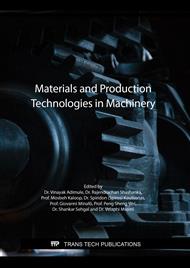[1]
Anonim, 2015. Statistik Produksi Hortikultura Tahun 2014, Jakarta: Direktorat Jenderal Hortikultura, Kementerian Pertanian.
Google Scholar
[2]
Andrianto, F., 2016. Pengaruh Sari Kulit dan Buah Semangka Merah (Citrullus lanatus) Sebagai Bahan Pengencer Terhadap Motilitas dan Viabilitas Spermatozoa Domba, Surabaya: Fakultas Kedokteran Hewan, Universitas Airlangga.
DOI: 10.15395/mkb.v48n3.842
Google Scholar
[3]
S. Mallek-Ayadi, N. Bahloul, and N. Kechaou, Characterization, phenolic compounds and functional properties of Cucumis melo L. peels,, Food Chem., vol. 221, p.1691–1697, (2017).
DOI: 10.1016/j.foodchem.2016.10.117
Google Scholar
[4]
S. J. Maleki, J. F. Crespo, and B. Cabanillas, Anti-inflammatory effects of flavonoids,, Food Chem., vol. 299, no. July, (2019).
Google Scholar
[5]
McDougall G J, Fyffe S, Dobson P, Stewart D. 2007. Anthocyanins from red cabbage-stability to simulated gastrointestinal digestion. Phytochemistry, 68, 1285–1294.
DOI: 10.1016/j.phytochem.2007.02.004
Google Scholar
[6]
Sunggil K, Doohyun B. Dong Y C, Eul-Tai L, Moo-Kyoung Y. 2009. Identification of two novel inactive DFR-A alleles responsible for failure to produce anthocyanin and development of a simple PCR-based molecular marker for bulb color selection in onion (Allium cepa L.). Theoretical and Applied Genetics, 118, 1391–1399.
DOI: 10.1007/s00122-009-0989-2
Google Scholar
[7]
Wang J, Mazza G. 2002. Effects of anthocyanins and other phenolic compounds on the production of tumor necrosis factor alpha in LPS/IFN-gamma-activated RAW 264.7 macrophages. Journal of Agricultural and Food Chemistry, 50, 4183–4189.
DOI: 10.1021/jf011613d
Google Scholar
[8]
Hou D X. 2003. Potential mechanisms of cancer chemoprevention by anthocyanins. Current Molecular Medicine, 3, 149–159.
DOI: 10.2174/1566524033361555
Google Scholar
[9]
Kong L, Chia N, Goh T, Chia R. 2003. Brouillard, analysis and biological activities of anthocyanins. Phytochemistry, 62, 923–933.
DOI: 10.1016/s0031-9422(03)00438-2
Google Scholar
[10]
M. Shafiq and Z. Singh, Pre-harvest spray application of phenylpropanoids influences accumulation of anthocyanin and flavonoids in 'Cripps Pink' apple skin,, Sci. Hortic. (Amsterdam)., vol. 233, no. February, p.141–148, (2018).
DOI: 10.1016/j.scienta.2018.01.020
Google Scholar
[11]
S. C. S. R. De Moura, C. L. Berling, S. P. M. Germer, I. D. Alvim, and M. D. Hubinger, Encapsulating anthocyanins from Hibiscus sabdari ff a L . calyces by ionic gelation : Pigment stability during storage of microparticles,, Food Chem., vol. 241, no. August 2017, p.317–327, (2018).
DOI: 10.1016/j.foodchem.2017.08.095
Google Scholar
[12]
Jamekhorshid, A., Sadrameli, S.M., Farid, M., 2014. A review of microencapsulation methods of phase change materials (PCMs) as a thermal energy storage (TES) medium. Renew. Sust. Energ. Rev. 31, 531-542.
DOI: 10.1016/j.rser.2013.12.033
Google Scholar
[13]
Gharsallaoui, A., Roudaut, G., Chambin, O., Voilley, A., Saurel, R., 2007. Applications of spray-drying in microencapsulation of food ingredients: An overview. Food Res. Int. 40, 1107-1121.
DOI: 10.1016/j.foodres.2007.07.004
Google Scholar
[14]
Gou, G.J., Dong, L.E., Bao, F.J., Wang, Z.Y., Jiao, L., Huang, J., Sun, Y., Xue, B., 2013. A review on research of the sustained release drug delivery system based on magnesium aluminate layered double hydroxide. Appl. Mech. Mater. 320, 495-504.
DOI: 10.4028/www.scientific.net/amm.320.495
Google Scholar
[15]
L. E. Kurozawa and M. D. Hubinger, Hydrophilic food compounds encapsulation by ionic gelation,, Curr. Opin. Food Sci., vol. 15, p.50–55, (2017).
DOI: 10.1016/j.cofs.2017.06.004
Google Scholar
[16]
Tsai, M.-L., Chen, R.-H., Bai, S.-W., & Chen, W.-Y. (2011). The storage stability of chitosan/tripolyphosphate nanoparticles in a phosphate buffer. Carbohydrate Polymers, 84(2), 756–761.
DOI: 10.1016/j.carbpol.2010.04.040
Google Scholar
[17]
Long L, Scardino A, Vasapollo G. 2007. Identification and quantification of anthocyanins in the berries of Pistacialen tiscus L., Phillyreala tifolia L. and Rubia peregrine L. Innovative Food Science and Emerging Technologies, 8, 360–364.
DOI: 10.1016/j.ifset.2007.03.010
Google Scholar
[18]
Domaratzki, R. E., & Ghanem, A. (2013). Encapsulation and release of cladribine from chitosan nanoparticles? Journal of Applied Polymer Science, 128(3), 2173–2179.
DOI: 10.1002/app.38354
Google Scholar
[19]
Rodrigues A S, Pérez M R, García M S, Simal J, Almeida D P. 2011. Effect of meteorological conditions on antioxidant flavonoids in portuguese cultivars of white and red onions. Food Chemistry, 124, 303–308.
DOI: 10.1016/j.foodchem.2010.06.037
Google Scholar
[20]
Pérez M R, Regueiro J, Simal J, Rodrigues A S, Almeida D P. 2014. Increasing the added-value of onions as a source of antioxidant flavonoids: A critical review. Critical Reviews in Food Science & Nutrition, 54, 1050–1062.
DOI: 10.1080/10408398.2011.624283
Google Scholar
[21]
Sarabandi, K., Jafari, S. M., Mahoonak, A. S., & Mohammadi, A. (2019). Application of gum Arabic and maltodextrin for encapsulation of eggplant peel extract as a natural antioxidant and color source. International Journal of Biological Macromolecules, 140, 59–68.
DOI: 10.1016/j.ijbiomac.2019.08.133
Google Scholar


